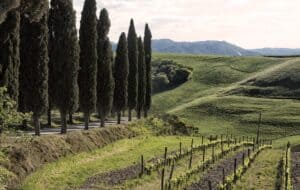The Via Francigena is the oldest route that crosses Europe, an artery road rich in beauty and history showing evidence of the different civilizations that wandered along this path over the centuries. Located on the most important pilgrim routes in Europe from Rome to Canterbury, the Via Francigena was the road of expansion for all the regions that it crossed. The city of Siena is known as the “daughter” of the Via Francigena.

Some parts of the Via Francigena have been approximated since a road with this name did not exist as a Roman consular road in the Middle Ages. The section towards France or Rome afforded innumerable variable routes for geographical or political reasons. There was no authority that could guarantee a road system of such great expanse. The Via Francigena could not be precisely marked out, instead it was a route with obligatory paths through nature or rest stops in cities or hospitals.
When a Holy Year was proclaimed in 1300, the Via Francigena began to see more traffic. In turn, more “Spedali” (hostels and hospitals) were built in addition to resting places for pilgrims many of which are evident today including the “Pieve”, parish churches in the countryside, and “Grance”, granges or merchant storehouses.
The Tuscan Section of the Francigena

In Tuscany, the Via Francigena formed a belt between medieval pilgrim itineraries since it was reachable from the ports of Liguria connecting it to the “Cammino di Santiago” and, continuing on from Rome, to the ports in Puglia for passage to the Holy Land.
The current SS2 highway runs along a route that was formed over the centuries on the old Roman Cassia Way and on the Via di Montebardone of the Lombards and Franks (today Passo della Cisa) that brought pilgrims from north Europe to Rome.
Even if the Via Francigena is known as a charming but uncomfortable road for travellers from centuries past when the unexpected was a daily occurrence, it favoured growth and development of many cities such as Montalcino, San Quirico, Abbadia San Salvatore, and Radicofani. Many people have recounted their adventures along their voyage including Sigeric the Archbishop of Canterbury, Philip II Augustus King of France on his way back from the Third Crusade, Boccaccio in his story about Cecco di Fortarrigo, De Sade, Montaigne, Dickens, Hawthorn, James and many other visitors who travelled on this great European way. Armies of crusaders on their way to Constantinople also trod on the Via Francigena.
In the past the Via Francigena came into Tuscany through the a pass on Monte Bardone, today Cisa, continuing on south along the Lunigiana and Versilia, towards the interior touching Lucca, crossing the Arno River at Fucecchio and back up to the Val d’Elsa to reach Siena. In the province of Siena, it followed the Val d’Arbia south and,, after wading through the Ombrone River in Buonconvento, it crossed Montalcino in the hamlet of Torrenieri to then cross the Asso and Tuoma creeks to meet the Orcia River in the valley on the left bank. Finally it reached the arduous rock of Radicofani to continue towards Paglia Creek and finally leaving Tuscany. This was an obligatory route that kept the traveller away from the border of the Exarchate of Ravenna and from the Tyrrhenian coast under the Byzantines.

The Via Fracigena today
Today many sections of the original Francigena are paved and used by cars and trucks, so the local administrations worked in synergy to create alternatives and, nowadays, it is possible to walk the entire Tuscan section on unpaved, quiet, country roads which pass through forests, fields and little villages.
Locals usually walk and bike here and you can occasionally meet people on horseback. The Tuscan section of the Via Francigena is nowadays a great trekking route to do on foot or by bike.








